ENDUSER: PACKAGING: Selecting the Right Adhesive Melters for Your Packaging Application

Adhesive Melters Defined
The deposition of thermoplastic (hot-melt) adhesives is the preferred method for carton sealing, case sealing, tray forming, pallet stabilization and a host of other packaging applications.Typically, hot-melt adhesives are manually fed (automated systems are available for higher volume operations) into the tank or hopper of an adhesive melter. As the adhesive is heated and melted, it is pumped through hoses from the tank to a dispensing gun where it is applied to the package.
Beyond basic functionality, packagers should consider specific requirements that will impact their choice of melter, including the following.
- Adhesive type
- Packaging application
- Line speed requirements
- Overall production environment
A variety of melters with a choice of system controls, melt styles, tank capacities, pump types and output connections are readily available to today's packagers. This article describes the benefits of each style and option in order to assist packagers in choosing the melter best suited to their operation.

System Controls
System control systems have advanced dramatically since the introduction of hot-melt dispensing systems in the mid-1960s. Today's melters are available with control packages ranging from simple on/off switches to programmable systems that monitor and control multiple temperature zones, production speeds, and communication interfaces.
- At-a-glance graphic interfaces
- Touch-screen controls
- Intuitive controls that allow operators to monitor, ready, fault, service and temperature status for the melter tank, hose and gun, with minimal training and language ability

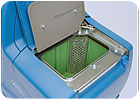
Adhesive Melting Methods
There are three basic ways to melt adhesives. Choosing the right one for your application can increase efficiency and reduce overall operating costs.Tank-style melters typically use cast-in heaters that heat all tank surfaces. Heaters located in the bottom of tanks, begin melting adhesive at the tank floor. Heat is conducted up the sides of the tanks, which helps to maintain consistent adhesive temperature. Tank-style melters are characterized by an open design that supports the widest variety of adhesive shapes and sizes. Tank designs now feature shapes that minimize corners where adhesive can become trapped and degrade, as well as non-stick surfaces for easier cleaning. Three-sided accessibility to the tank is an important consideration, allowing easy tank filling while minimizing spillage and adhesive waste.
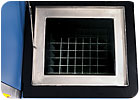
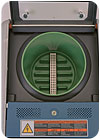

Tank/Hopper Capacities
Packaging operations and applications ranging from agricultural manual packing to high-speed, high-volume beverage packaging can require adhesive melters with tank capacities as small as a few ounces (hand held) or as great as 200 lbs. Tank capacity requirements are primarily determined by the amount of adhesive that must be melted and pumped in a given period of time (throughput rate).
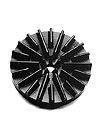
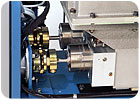
Pump Types
The level of precision required in your packaging operation best determines the pump style of your adhesive melter. Choosing the right melter and pump style can have a positive impact on the output capabilities and efficiency of your adhesive dispensing.Selection of pump type is contingent upon operational requirements including:
- Continuous or intermittent adhesive output
- Adhesive type
- Adhesive viscosity ranges
- Output precision required
- Amount of filler in the adhesive
- User preferences
Additionally, pump sizes can be specified for various outputs. In some instances, multiple pumps are used to meet high output requirements or to provide a variety of output rates from a single melter.
Piston pumps use an air piston to move a hydraulic plunger, and can be either single- or dual-action. They provide constant pressure with variable flow and are widely used for intermittent dispensing applications, making them ideal for most packaging operations. The piston pump is also conducive for use with corrosive and abrasive materials as it allows more adhesive to pass through. Choosing a melter with automatic pressure discharge (APD) will allow pressure to be discharged into the tank in seconds, providing superior safety for operators.
Spur gear pumps employ counter-rotating gears to deliver variable pressure and constant adhesive flow. The gears create positive displacement for precise metering of material. Spur gear pumps accommodate a range of material viscosities and are ideally suited for applications that require high-speed output, like beverage packaging. Spur gear pumps are commonly coupled with variable-speed drives to provide flexibility and synchronization of output to production line speeds when necessary.

Additional Options
Melters can be customized with a variety of options to increase operating efficiency or meet specific manufacturing requirements. Options can be as simple as adding casters (for increased mobility) or a light tower (for more visible system monitoring), to more complex, such as specialized communication systems that integrate with parent machinery. Today's melter designs and technology make it possible to equip the simplest manual applicators or the most complex of machines with a variety of interface and operational capabilities.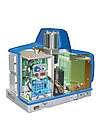
Looking to the Future
While almost any adhesive melter will melt and pump adhesive safely, choosing the correct melter for your packaging application can boost the productivity of a packaging line/operation, reduce adhesive costs and waste, minimize maintenance and downtime, provide better bonding and sealing of packages, and provide the flexibility to meet multiple packing application requirements.For more information, contact Nordson Corp., 11475 Lakefield Drive, Duluth, GA 30097; phone (800) 683-2314; or visit http://www.nordson.com .
Links
Looking for a reprint of this article?
From high-res PDFs to custom plaques, order your copy today!


